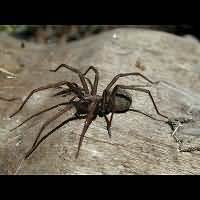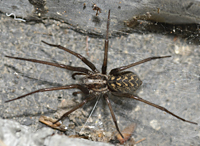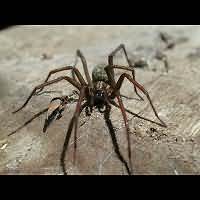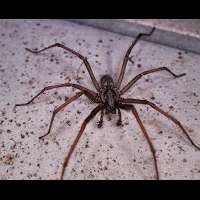[All pictures of garden wildlife on this page are thumbnails. Click on any thumbnail for a large format to be displayed.]
Common House Spider (Tegenaria atrica, Tegenaria saeva)
The scary Common House Spider is the real nightmare suffering from arachnophobia ![]() !
!
First of all I need to mention that there are two Tegenaria species that look practically identical. These are: Tegenaria saeva (usually known as Tegenaria atrica) and Tegenaria gigantea (also referred to as Tegenaria duellica). Without microscopic research of their genitals it is impossible to determine the exact species. Other similar spider is Tegenaria domestica, Tegenaria agrestis and Tegenaria parietina. Since I always try to avoid killing or even disturbing the creatures in my garden, I am not going to go put my spiders under and invasive investigation. Therefore the statement that the photos here actually do depict Tegenaria saeva is based on an assumption.
This big dark hairy spider can be found indoors and outdoors.
Reaching the sizes of up to 1.8cm for females and up to 1.5cm for males, Tegenaria atrica is one of the biggest spiders of Western and Central Europe. They are very fast and can run at the speed of 50 cm/s! It belongs to the family of Cob-web Spiders (Agelenidae) that can often be found in the house: Common House Spider. These large house spiders take two years to reach maturity. They can be found indoors regularly and this is the most common one of them. Especially during the night the males often actively search for the females. Both sexes look quite similar showing the same dark brown coloration. Females are hardly bigger than males and actually look smaller: the males have a leaner body, but much longer legs. The pattern on opisthosoma (abdomen) shows six spots on each side (see above detailed photograph) and the legs are uniformly colored. Their lifespan is about two to three years.
Latin names of the large house spider (saevus = cruel or savage and duellicus = warlike) already suggest that this is not a friendly creature.
The infamous North American Hobo Spider, also known as Biting House Spider (Tegenaria agrestis) is a close relative of the Common Housespider above and it even looks similar. The animal is not known to bite people in Europe, but somehow it does bite in the USA. The venom causes open wounds that heal very slowly. Most of the members of the Tegenaria genus however are either unable to penetrate the human skin or their venom is very weak indeed. Adult males are found from July to October only while adult females all year. In the United Kingdom Common Housespider is also known as as the Dust Spider or the Dustbunny Spider and you can easily guess why.
From close-by this giant spider actually looks quite fascinating...

© Copyright 1998-2024 gardensafari.net (Hania Berdys)

 English / engels
English / engels  Dutch / nederlands
Dutch / nederlands










